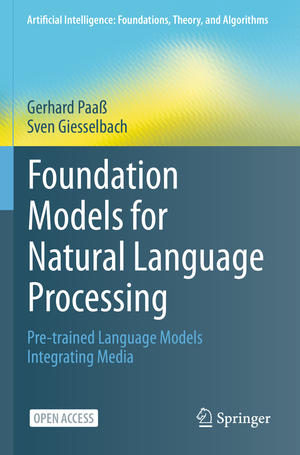

Foundation Models for Natural Language Processing - Pre-trained Language Models Integrating Media – Buch neu kaufen
Möchten Sie selbst gebrauchte Bücher verkaufen? So einfach geht's …
Verkäufer-Bewertung:
100,0% positiv (3 Bewertungen)
dieses Buch wurde bereits 1 mal aufgerufen
dieses Buch wurde bereits 1 mal aufgerufen

Preis:
47,28 €
*
versandkostenfrei
Neuware
Dieses Bild ist kein Original-Foto des angebotenen Exemplars. Abweichungen sind möglich.
* Inkl. Mwst.
Autor/in:
Titel:
ISBN:
9783031231926
(ISBN-10: 3031231929)Zustand:
Neuware
Einband:
Taschenbuch
Sprache:
Englisch
Verlagstext:
This open access book provides a comprehensive overview of the state of the art in research and applications of Foundation Models and is intended for readers familiar with basic Natural Language Processing (NLP) concepts.
Over the recent years, a revolutionary new paradigm has been developed for training models for NLP. These models are first pre-trained on large collections of text documents to acquire general syntactic knowledge and semantic information. Then, they are fine-tuned for specific tasks, which they can often solve with superhuman accuracy. When the models are large enough, they can be instructed by prompts to solve new tasks without any fine-tuning. Moreover, they can be applied to a wide range of different media and problem domains, ranging from image and video processing to robot control learning. Because they provide a blueprint for solving many tasks in artificial intelligence, they have been called Foundation Models.
After a brief introduction to basic NLP models the main pre-trained language models BERT, GPT and sequence-to-sequence transformer are described, as well as the concepts of self-attention and context-sensitive embedding. Then, different approaches to improving these models are discussed, such as expanding the pre-training criteria, increasing the length of input texts, or including extra knowledge. An overview of the best-performing models for about twenty application areas is then presented, e.g., question answering, translation, story generation, dialog systems, generating images from text, etc. For each application area, the strengths and weaknesses of current models are discussed, and an outlook on further developments is given. In addition, links are provided to freely available program code. A concluding chapter summarizes the economic opportunities, mitigation of risks, and potential developments of AI.
Over the recent years, a revolutionary new paradigm has been developed for training models for NLP. These models are first pre-trained on large collections of text documents to acquire general syntactic knowledge and semantic information. Then, they are fine-tuned for specific tasks, which they can often solve with superhuman accuracy. When the models are large enough, they can be instructed by prompts to solve new tasks without any fine-tuning. Moreover, they can be applied to a wide range of different media and problem domains, ranging from image and video processing to robot control learning. Because they provide a blueprint for solving many tasks in artificial intelligence, they have been called Foundation Models.
After a brief introduction to basic NLP models the main pre-trained language models BERT, GPT and sequence-to-sequence transformer are described, as well as the concepts of self-attention and context-sensitive embedding. Then, different approaches to improving these models are discussed, such as expanding the pre-training criteria, increasing the length of input texts, or including extra knowledge. An overview of the best-performing models for about twenty application areas is then presented, e.g., question answering, translation, story generation, dialog systems, generating images from text, etc. For each application area, the strengths and weaknesses of current models are discussed, and an outlook on further developments is given. In addition, links are provided to freely available program code. A concluding chapter summarizes the economic opportunities, mitigation of risks, and potential developments of AI.
Stichwörter:
Angebot vom:
27.10.2024
Bestell-Nr.:
SHUB261307
Lieferzeit:
Sofort bestellen | Anfragen | In den Warenkorb
Verwandte Artikel
Verkäufer/in dieses Artikels
Verkäufer/in

thebookhouse123
(Australien,
Antiquariat/Händler)
>> Benutzer-Profil (Impressum) anzeigen
>> Verkäufer in die Buddylist
>> Verkäufer in die Blocklist
Angebote: Bücher (52339)
>> Benutzer-Profil (Impressum) anzeigen
>> Verkäufer in die Buddylist
>> Verkäufer in die Blocklist
Angebote: Bücher (52339)
Angebotene Zahlungsarten
(Vorkasse)
- Skrill/Moneybookers (Vorkasse)
Ihre allgemeinen Versandkosten
| Ihre allgemeinen Versandkosten gestaffelt nach Gewicht | |||
|---|---|---|---|
| Gewicht | Australien | EU | Welt |
| bis 500 g | frei | 5,00 € | 5,00 € |
| bis 1000 g | frei | 5,00 € | 5,00 € |
| bis 2000 g | frei | 5,00 € | 5,00 € |
| darüber | frei | 5,00 € | 5,00 € |
Hinweis: Unten genannte pauschalen Versandkosten werden nur verwendet, wenn bei einem Angebot die Gewichtsangabe fehlt oder bei einem Bestellwert ab 5,00 €; ansonsten wird der Versand nach der Gewichts-Staffel berechnet.
| Landweg | |||
| Australien | EU | Welt | |
| Versand pauschal | frei | 5,00 € | 5,00 € |
| pauschal ab 5,00 € | frei | 5,00 € | 5,00 € |
| Versandkostenfrei ab | frei | 5,00 € | 5,00 € |
